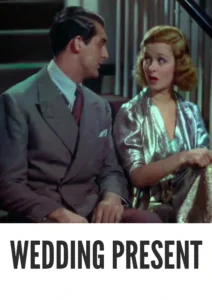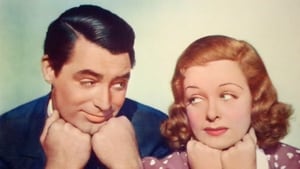Video Sources 0 Views
- Wedding Present 1936 Colorized


Synopsis
Table of Contents
ToggleHigh Jinks and Headlines: Wedding Present (1936) in Dazzling Color

Dive into the delightful world of Wedding Present, a sparkling screwball comedy from 1936, now beautifully colorized for a fresh and engaging viewing experience. Also known as Divorce Me, Darling, this film, directed by Richard Wallace, serves up a hilarious blend of romance and journalism, showcasing the antics of a newlywed couple who can’t quite leave their reporter days behind. Perfect for fans of classic comedies and those who enjoy a touch of old-fashioned romance, this HD download brings a lighthearted and charming piece of cinematic history to your screen.
Wedding Present Storyline: A Honeymoon of Headlines and Hijinks
Wedding Present tells the story of Rusty (Joan Bennett) and Charlie (Cary Grant), two rival reporters who impulsively decide to get married. However, their passion for journalism and practical jokes continues into their married life, leading to a series of comical situations.Their honeymoon is anything but traditional, as they find themselves embroiled in various schemes and escapades, from publishing scandalous stories to staging elaborate pranks. As their antics escalate, they must navigate the challenges of married life while trying to maintain their individual identities and careers. The film is a whirlwind of witty banter, slapstick humor, and heartwarming moments, making it a quintessential screwball comedy. Ultimately, Wedding Present is a celebration of love, laughter, and the art of not taking life too seriously.
Movie Cast
The film features a stellar cast of actors who bring this comedic story to life:
- Joan Bennett as Rusty
- Cary Grant as Charlie Mason
- George Bancroft as Police Chief Magoon
- Conrad Nagel as Roger Dodacker
- Genevieve Tobin as Monica Fleming
Movie Genre
Wedding Present, also known as Divorce Me, Darling, falls squarely into the screwball comedy genre, with elements of romance and satire that are characteristic of the era. Its fast-paced dialogue, zany characters, and absurd situations make it a quintessential example of this beloved genre.
Historical Context: The Golden Age of Screwball Comedy
Released in 1936, Wedding Present emerged during the Golden Age of Hollywood, a time when screwball comedies were at their peak. These films often featured witty dialogue, absurd situations, and strong female characters, reflecting the changing roles of women in society. Wedding Present captures the spirit of this era, offering a lighthearted and escapist view of love and marriage during the Great Depression. While not as widely known as some of its contemporaries, the film remains a delightful and entertaining example of classic Hollywood comedy.
Colorization Details
This colorized version of Wedding Present has been meticulously restored using modern digital techniques, enhancing the visual appeal while preserving the film’s original charm and wit. The colorization process involved carefully analyzing the grayscale tones of the original black and white footage and assigning appropriate colors to each scene. While the specific software used remains proprietary, the techniques employed included advanced algorithms for color palette selection and image enhancement. This painstaking process brings new life to the characters and settings, making the story even more engaging for modern audiences. While some may debate the merits of colorizing classic films, it introduces these films to a broader audience, ensuring their legacy for future generations.
Technical Details
- Director: Richard Wallace
- Screenplay: Joseph Anthony Fields, David Boehm
- Story: Paul Gallico
- Cinematography: Leon Shamroy
- Edited by: Francis D. Lyon
- Production Company: Paramount Pictures
- Distributed by: Paramount Pictures
- Runtime: 81 minutes
Technical Specifications
- Download Format: MP4
- Resolution: HD (1080p)
- Compatibility: Compatible with most devices, including smartphones, tablets, computers, and smart TVs.
Reviews and Critical Reception
Wedding Present (1936) is often praised for its witty dialogue, charming performances, and lighthearted approach to love and marriage. While it may not be considered a cinematic masterpiece, it remains a delightful and entertaining example of classic Hollywood comedy. As a relatively obscure but intriguing film, Wedding Present provides a unique perspective on the Golden Age of Hollywood.
FAQs
- Q: What is Wedding Present about?
- A: Wedding Present is a screwball comedy about two rival reporters who get married and continue their antics into married life.
- Q: Is Wedding Present (1936) a well-known Cary Grant film?
- A: While not as famous as some of his other films, Wedding Present offers a delightful glimpse into Cary Grant’s comedic talents.
- Q: Is this version of Wedding Present colorized?
- A: Yes, this version has been professionally colorized to enhance the viewing experience.
- Q: What makes Wedding Present interesting for classic film fans?
- A: Wedding Present offers valuable insights into the Golden Age of Hollywood, showcasing the era’s wit, charm, and lighthearted approach to storytelling.
- Q: What is the download format?
- A: The download format is MP4, which is compatible with most devices.
- Q: What resolution is the download?
- A: The resolution is HD (1080p), providing a high-quality viewing experience.
Download Now in HD!
Watch Wedding Present Today!











